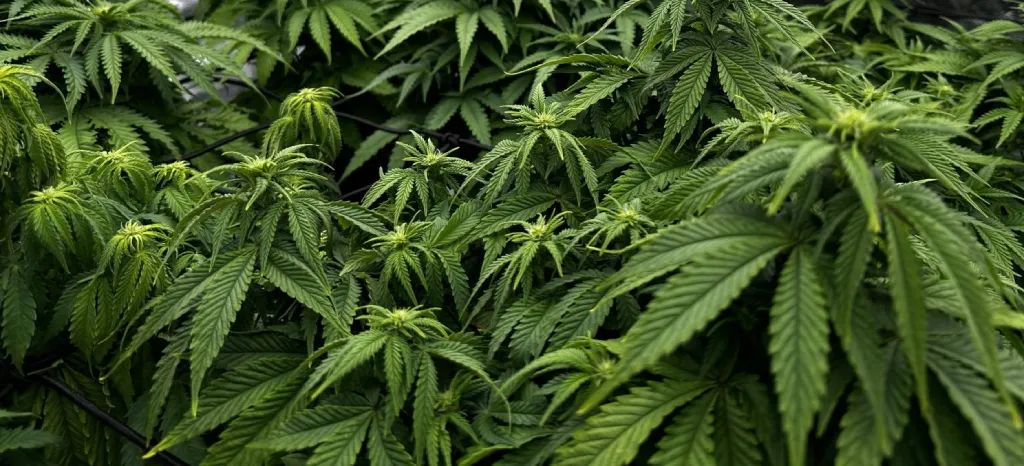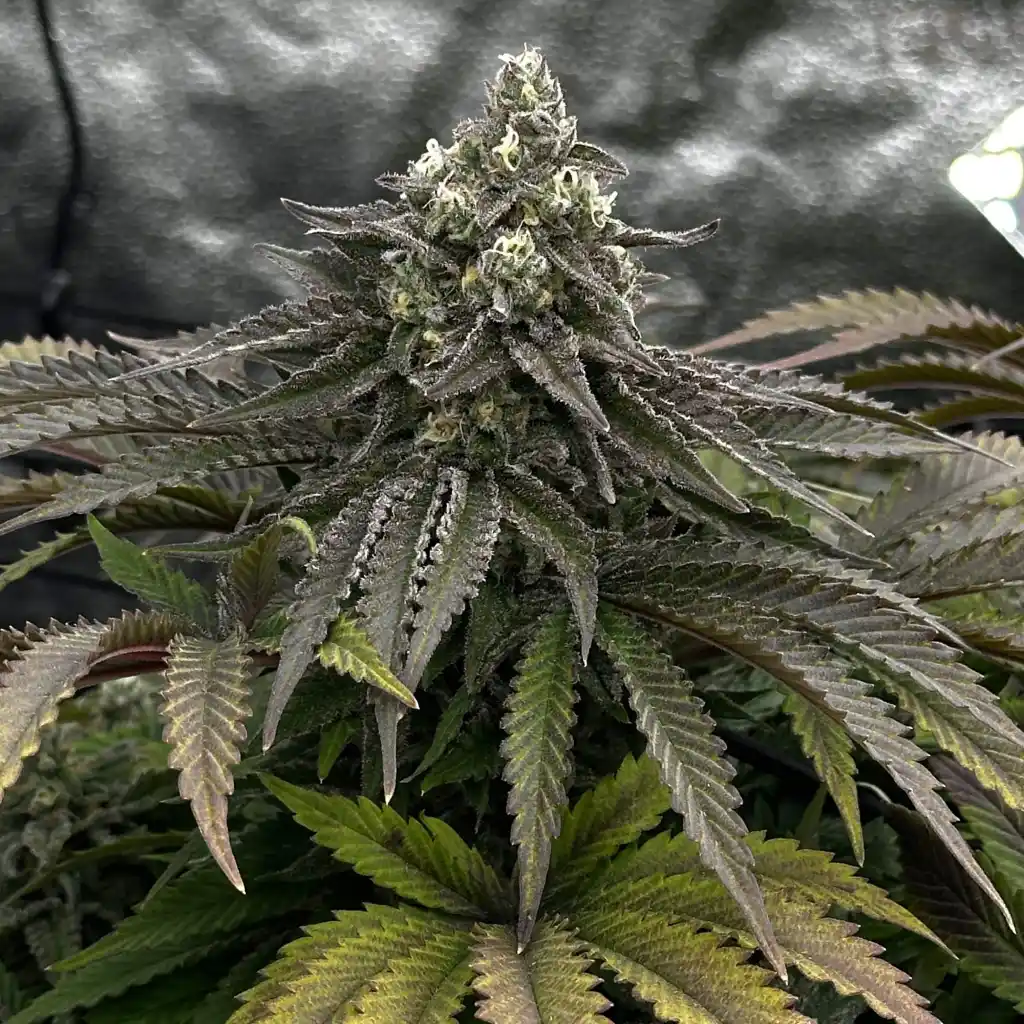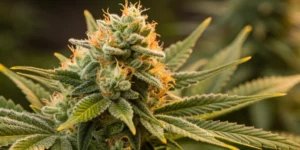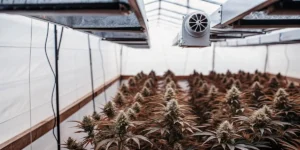Exceptional Genetics and Effects
The Super Critical strain is a powerhouse hybrid bred from Big Bud, Skunk #1, and White Widow. This combination results in a robust and versatile cannabis plant with exceptional characteristics. Known for its potency, this strain boasts THC levels that often reach 18-22%, making it ideal for experienced users seeking a strong, relaxing effect.
Super Critical offers a balanced profile of indica and sativa effects, leaning slightly towards indica dominance. This results in a deep body relaxation complemented by uplifting mental clarity. The strain’s effects are ideal for combating stress, chronic pain, and insomnia while enhancing mood and creativity. Its genetics also contribute to its ability to deliver impressive yields, making it a favorite among growers.
The flavor and aroma profile of Super Critical is just as noteworthy. Expect earthy, skunky undertones blended with hints of citrus and spice. This terpene-rich profile enhances the overall smoking or vaping experience, solidifying its reputation as a top-tier strain for both medicinal and recreational users.
Environmental Requirements for Growing Super Critical Strain
Growing Super Critical strain successfully requires understanding its environmental needs. This strain thrives in warm, Mediterranean-like climates when grown outdoors. Indoor cultivators should aim to replicate these conditions by maintaining temperatures between 70-85°F (21-29°C) and humidity levels between 40-50% during flowering.
The strain is adaptable to various growing methods, including soil and hydroponics. However, its dense bud structure makes airflow critical to prevent mold or mildew. Ensure proper ventilation in indoor setups and avoid overwatering, as this can lead to root rot. With the right environmental care, Super Critical delivers dense, resinous buds packed with flavor and potency.
Setting Up the Growing Cannabis Space
Setting up a growing space for Super Critical strain is a straightforward process that requires attention to detail. For indoor cultivation, choose a grow tent or room with reflective walls to maximize light exposure. Equip the space with LED or HID grow lights to ensure the plants receive sufficient light intensity throughout their growth cycle. This setup also works well for Auto Mac #1, a strain that thrives under controlled indoor conditions with proper lighting and ventilation.
Invest in essential tools such as hygrometers, thermometers, and pH meters to monitor environmental conditions. A ventilation system with fans and carbon filters will help maintain airflow and manage odor. When setting up for hydroponics, include a nutrient reservoir and irrigation system to deliver precise feeding.
For outdoor grows, select a location with ample sunlight and well-draining soil. Ensure the area is secure from pests and harsh weather conditions by using fencing or a greenhouse. With a well-prepared space, growers can optimize the potential of Super Critical strain, ensuring a healthy and productive crop.
Indoor Cannabis Cultivation
Indoor cultivation offers control over environmental factors, making it an excellent choice for growing Super Critical strain. Begin by selecting a medium such as soil, coco coir, or a hydroponic system, depending on your expertise and resources. Use a light schedule of 18 hours on and 6 hours off during the vegetative phase, switching to 12 hours on and 12 hours off during flowering.
Maintain consistent temperatures between 70-80°F (21-27°C) and keep humidity levels at 50-70% during the vegetative stage. Lower humidity to 40-50% during flowering to prevent mold. Train your plants using low-stress training (LST) or the Screen of Green (ScrOG) method to manage height and maximize yields. Regular pruning helps improve airflow and light penetration, leading to healthier plants and better-quality buds.
Outdoor Cannabis Cultivation
Outdoor cultivation allows Super Critical strain to reach its full potential, especially in climates with long, warm summers. Plant seeds or clones in nutrient-rich, well-draining soil after the last frost. Space the plants generously to ensure they have enough room to grow and receive adequate sunlight.
Monitor for pests such as aphids or spider mites and use organic pesticides or companion planting to deter them. Water deeply but infrequently to encourage strong root development, and mulch around the base of the plants to retain moisture and suppress weeds. Harvest outdoor plants by mid to late October when grown in the Northern Hemisphere, ensuring the buds have matured fully for maximum potency and flavor.
Propagation and Germination of Super Critical Strain
Propagation and germination are pivotal in ensuring the success of Super Critical Strain cultivation. A solid start during these stages guarantees healthy growth and maximized yields, setting the tone for a rewarding harvest.
Propagation Basics
Start with premium-quality seeds for reliable germination. Mature seeds are dark brown with a smooth, hard shell and should be stored in a cool, dark, and dry location until ready for planting. To prevent contamination or pest infestations during propagation, always ensure your grow space is sanitized. Using sterile equipment and maintaining a clean environment are essential for a successful propagation process.
Additionally, soaking seeds in distilled water for 12-24 hours before germination can speed up the process. This method helps soften the seed shell, increasing the likelihood of a successful sprout. Ensure the soaking environment maintains a steady temperature of 70-80°F to optimize results.
Germination Techniques
For germinating Super Critical Strain seeds, the paper towel method remains a popular choice due to its simplicity and effectiveness. Here’s how to do it:
- Dampen a paper towel with distilled water and place your seeds on one side.
- Cover the seeds with another damp paper towel and fold it over gently.
- Store the paper towels in a warm, dark area with temperatures around 70-80°F.
- Check daily to ensure the towels remain moist but not soaked.
Within 2-5 days, the seeds should sprout taproots. Once the roots reach about 1-2 centimeters, carefully transplant them into a nutrient-rich growing medium to promote healthy development. For added success, use biodegradable starter plugs or peat pots, which allow for seamless transplantation without stressing the roots.
Vegetative Phase of Super Critical Strain
The vegetative phase is crucial for establishing a strong foundation, as this is when Super Critical Strain plants develop vigorous stems and abundant foliage.
Light Requirements
Super Critical Strain thrives under consistent lighting during this stage. Provide 18-24 hours of light daily using high-quality LED or HID grow lights. Position the lights 18-24 inches above the canopy to prevent light burn and ensure even distribution across all plants. Proper lighting is key to robust growth during this phase.
Rotating the plants every few days ensures all sides receive adequate light exposure, promoting uniform growth. Coupling this with reflective materials around the grow area further optimizes light efficiency, minimizing wasted energy and maximizing plant development.
Nutrients and Watering
During the vegetative phase, focus on a nutrient plan that prioritizes nitrogen to encourage foliage growth. A recommended NPK ratio is 3-1-2 to ensure balanced development. Water your plants consistently, allowing the top inch of soil to dry between waterings. Overwatering can lead to root rot, so monitor moisture levels carefully. Proper hydration promotes strong root systems and overall plant health.
To further enhance growth, consider adding calcium and magnesium supplements. These nutrients support strong cell walls and improve the plant’s ability to absorb other essential elements. Monitor the pH of your water and nutrient solution, aiming for a range of 6.0-6.5 for soil or 5.5-6.0 for hydroponics.
Training Techniques
To optimize yields, employ training techniques such as low-stress training (LST) or topping. These methods encourage lateral growth, creating an even canopy and allowing better light penetration. Properly trained plants not only maximize yield potential but also enhance bud quality during flowering.
Another advanced method, known as screen of green (ScrOG), involves using a net or screen to direct plant growth horizontally. This technique works particularly well for indoor setups, ensuring every bud site receives adequate light and airflow.
Flowering Phase of Super Critical Strain
The flowering phase is when Super Critical Strain reveals its true potential, producing dense, resinous buds that define its reputation for quality and potency.
Transitioning to Flowering
Super Critical Strain typically transitions to the flowering phase after 8-9 weeks of vegetative growth. To induce flowering, adjust the light cycle to 12 hours of light and 12 hours of complete darkness. Ensure the dark period remains uninterrupted, as any light exposure during this time can stress the plants and cause hermaphroditism.
Nutrient Adjustments
During flowering, shift the nutrient focus to phosphorus and potassium, which are essential for bud development and resin production. A typical NPK ratio for this stage is 1-3-4. Gradually reduce nitrogen levels to minimize excess foliage growth and direct energy toward bud formation.
Supplement your feeding regimen with bloom enhancers containing trace elements like sulfur and boron. These micronutrients play a pivotal role in terpene production, enhancing the aroma and flavor profile of your harvest.
Monitoring Humidity and Temperature
Maintain optimal environmental conditions to support healthy flowering. Keep humidity levels between 40-50% to prevent mold or mildew, and maintain temperatures of 68-78°F during the day with slightly cooler nights. Proper environmental control enhances resin production and the terpene profile, resulting in flavorful and potent buds. Using a dehumidifier during the flowering stage can further protect your plants from excess moisture. Additionally, oscillating fans ensure consistent airflow, reducing the risk of stagnant pockets where mold might thrive.
Cannabis Fertilization and Nutrition – Super Critical Strain
Nutritional balance is vital for cultivating Super Critical Strain successfully. Providing plants with the right nutrients at each stage ensures vigorous growth and exceptional yields.
Essential Nutrients
In the vegetative stage, nitrogen is critical for promoting lush foliage and stem development. As the plants enter the flowering phase, prioritize phosphorus and potassium for robust bud growth and resin production. Regularly monitor nutrient levels and adjust your feeding schedule based on plant response to prevent deficiencies or toxicity.
Foliar feeding during the early vegetative stage can provide a quick nutrient boost. This method delivers essential elements directly to the leaves, promoting rapid recovery from minor deficiencies. However, discontinue foliar applications once flowering begins to avoid affecting bud quality.
Organic vs. Synthetic Fertilizers
Super Critical Strain responds well to both organic and synthetic fertilizers. Organic options, such as compost tea or fish emulsion, enhance soil quality and promote beneficial microbial activity. Synthetic fertilizers, like premixed NPK solutions, offer precise control over nutrient ratios and faster absorption. Choose a fertilizer type based on your growing style and preferences to achieve optimal results.
For a balanced approach, many growers use a hybrid method, combining the natural benefits of organic amendments with the precision of synthetic nutrients. This strategy provides robust plant health while maintaining control over the feeding schedule.
Pest and Disease Control for Cannabis Growing
Effective pest and disease management is essential for safeguarding Super Critical Strain plants. Prevention and early intervention are key to ensuring a healthy and productive grow cycle.
Common Pests
Super Critical Strain is prone to common pests like spider mites, aphids, and fungus gnats. These pests can damage foliage, stunt growth, and reduce overall yields. Regularly inspect plants for signs of infestation, such as discolored leaves, webbing, or the presence of insects on the undersides of leaves.
Integrated pest management (IPM) strategies, including introducing beneficial insects like ladybugs or predatory mites, can help control infestations naturally. Combining biological controls with manual removal ensures minimal reliance on chemical treatments.
Preventive Measures
- Cleanliness: Keep your grow area clean by removing debris and sanitizing tools frequently.
- Ventilation: Maintain proper airflow with oscillating fans to deter pests and reduce humidity levels.
- Natural Repellents: Use neem oil, insecticidal soaps, or diatomaceous earth to prevent and manage pest infestations effectively.
Disease Management
Fungal diseases such as powdery mildew and root rot can threaten the health of Super Critical Strain plants. To mitigate risks, maintain humidity levels within the recommended range and avoid overwatering. Treat fungal infections with organic fungicides or introduce beneficial microbes to combat pathogens. Vigilant monitoring and quick action can protect your plants from potential threats.
For added protection, consider using silica-based supplements during feeding. Silica strengthens cell walls, making plants more resistant to both pests and diseases while improving overall resilience.
Growing Prevention Corrective Actions
Preventive actions are the cornerstone of maintaining a healthy growing environment for Super Critical Strain. Regular monitoring and timely corrections ensure plants thrive and are less vulnerable to stressors or disease. Begin by establishing a consistent inspection routine to identify early signs of issues like discoloration, pests, or nutrient deficiencies. Healthy plants often exhibit vibrant green foliage and upright posture, so any deviation signals the need for intervention.
When problems arise, corrective actions depend on the nature of the issue. For instance, addressing nutrient deficiencies involves adjusting the nutrient mix, while pest infestations may require targeted treatments such as neem oil or insecticidal soaps. Keeping a detailed grow journal documenting conditions, feeding schedules, and observations can help pinpoint potential causes and prevent recurrence.
Harvesting and Curing for Cannabis Growing
The harvest phase is one of the most rewarding parts of cultivating Super Critical Strain, but timing and technique are key to maximizing quality. Look for signs that the buds are ready to harvest, such as milky or amber trichomes and the darkening of pistils. Using a magnifying glass or jeweler’s loupe to examine trichomes ensures precision, as harvesting too early or late can affect potency and flavor.
After cutting the plants, begin the curing process by drying buds in a controlled environment with humidity levels of 50–60% and temperatures around 65–75°F. Once dried, store buds in airtight containers and open them periodically (burping) to release excess moisture. Proper curing can take up to three weeks and enhances the terpene profile, ensuring smooth smoke and long-lasting freshness.

Is Super Critical Strain Indica or Sativa?
Super Critical Strain is a hybrid cannabis variety that leans slightly toward indica dominance. This genetic makeup combines the relaxing effects of indica strains with the uplifting qualities of sativas, making it versatile for both recreational and medical users. The balanced properties cater to those seeking relaxation without excessive sedation.
Advantages of Growing Super Critical Strain
One of the main advantages of growing Super Critical Strain is its high yield potential. With the right care, this strain produces dense, resin-rich buds that appeal to commercial growers and home cultivators alike. Its robust nature ensures consistent results even for less experienced growers, as it responds well to different cultivation methods.
Additionally, Super Critical Strain has a relatively short flowering period of about 7–8 weeks, making it a quick and efficient option for those eager for a fast harvest. The strain’s high resistance to pests and diseases adds to its appeal, reducing the likelihood of complications during the grow cycle.
Disadvantages of Growing Super Critical Strain
Despite its many advantages, Super Critical Strain does have a few challenges. Its dense bud structure makes it more susceptible to mold if humidity levels aren’t carefully controlled. Growers must maintain proper ventilation and monitor environmental conditions to prevent issues during flowering.
Another drawback is its heavy feeding requirements. This strain thrives on nutrient-rich diets, and failure to provide the right balance can result in nutrient deficiencies or stunted growth. While manageable, these needs require attentiveness and may not suit those seeking a low-maintenance grow.
Problems in Cultivating Super Critical Strain
Cultivating Super Critical Strain can sometimes present challenges, particularly for growers who are unprepared for its specific requirements. Overwatering is a common mistake, as excessive moisture can lead to root rot and compromised plant health. Ensuring proper drainage and watering schedules is essential for success.
Pests like spider mites and aphids can also pose problems if not addressed promptly. Regular inspection and preventive measures such as neem oil or introducing beneficial insects like ladybugs can mitigate these risks. By anticipating these challenges, growers can take proactive steps to avoid setbacks and ensure a productive harvest.
Similar Strains
White Widow
White Widow is a balanced hybrid strain known for its uplifting effects and high resin production. Similar to Super Critical Strain, it features a robust growth profile and versatility in various climates. White Widow’s spicy, earthy flavor complements its energizing yet relaxing high, making it a favorite among cannabis enthusiasts. This strain’s resilience against pests and diseases makes it a reliable choice for growers aiming for high-quality yields without excessive maintenance.
Big Bud
Big Bud earns its name from its enormous, resinous flowers, making it a strong contender for growers seeking maximum yields. This indica-dominant strain shares the high productivity and potent effects of Super Critical Strain, with a slightly more sedative profile. Big Bud offers a sweet, fruity aroma and a deeply relaxing high, ideal for nighttime use. It’s best suited for indoor cultivation with controlled lighting to optimize its growth and flowering potential.
Northern Lights Auto
Northern Lights Auto is a classic indica strain known for its resilience and potent calming effects. Like Super Critical Strain, it’s easy to grow and produces high yields, making it an excellent option for both beginners and experts. Its sweet and spicy aroma, coupled with its deeply sedative effects, makes it perfect for unwinding after a long day. Northern Lights thrives in indoor setups but can also adapt to outdoor cultivation in warmer climates.
Week-by-Week Growth Plan for Super Critical Strain
Week 1-2: Germination Phase
During the germination phase, ensure your seeds are kept in a warm, dark, and moist environment. Use the paper towel method or plant directly into a nutrient-rich growing medium. Maintain temperatures between 70-80°F and keep humidity levels high, around 70-80%, to encourage root development.
Week 3-4: Early Vegetative Stage
In the early vegetative stage, focus on establishing a strong root system and healthy foliage. Provide 18-24 hours of light daily using LED or HID grow lights. Feed the plants with a nutrient solution high in nitrogen, following an NPK ratio of 3-1-2. Keep temperatures stable at 70-80°F and reduce humidity slightly to 60-70%.
Week 5-6: Late Vegetative Stage
Plants will exhibit rapid growth during the late vegetative stage, requiring more water and nutrients. Continue with high nitrogen feedings and introduce training techniques such as topping or low-stress training (LST) to maximize yield potential. Ensure even light distribution and maintain environmental conditions with temperatures between 68-78°F and humidity at 50-60%.
Week 7-8: Transition to Flowering
Switch the light cycle to 12 hours of light and 12 hours of darkness to initiate flowering. Gradually reduce nitrogen levels and increase phosphorus and potassium in the nutrient mix. Monitor plants closely for signs of stress and maintain consistent temperatures around 68-77°F. Lower humidity further to 45-55% to prevent mold and mildew.
Week 9-11: Early Flowering Stage
During early flowering, buds will begin to form, and resin production will increase. Feed plants with a nutrient solution focused on phosphorus and potassium, with minimal nitrogen. Maintain humidity levels at 40-50% and temperatures around 68-75°F. Avoid disturbing the dark period, as any light exposure can stress the plants.
Week 12-13: Mid-Flowering Stage
By mid-flowering, buds will swell, and trichome production will be at its peak. Continue feeding with a flowering-specific nutrient solution and consider adding a bloom booster for enhanced results. Keep humidity levels low, around 35-45%, and maintain temperatures at 68-75°F. Inspect plants regularly for pests or nutrient deficiencies.
Week 14-15: Late Flowering Stage
In the final weeks, flush the plants with pure water to remove any residual nutrients, enhancing the flavor and quality of the buds. Humidity should remain at 30-40%, and temperatures should be slightly cooler, around 65-75°F, to encourage resin production. Monitor trichome coloration to determine the optimal harvest time.
Week 16: Harvest
When the trichomes are mostly cloudy with some amber hues, it’s time to harvest. Cut the plants at the base and hang them upside down in a dark, well-ventilated space to dry. After drying, cure the buds in airtight jars, burping them daily for the first two weeks to maintain freshness and potency.
By following this detailed week-by-week guide, growers can maximize the potential of Super Critical Strain, achieving robust yields and exceptional quality.
FAQs About Super Critical Strain
What are the effects of Super Critical Strain?
Super Critical Strain provides a balanced mix of relaxing and uplifting effects. The indica dominance offers deep physical relaxation, while the sativa genetics contribute to a mild cerebral buzz, making it ideal for both recreational and medical use.
Is Super Critical Strain beginner-friendly?
Yes, this strain is considered beginner-friendly due to its resilience and high yield potential. Its ability to adapt to various growing environments and its resistance to common pests make it an excellent choice for novice cultivators.
What is the average THC content of Super Critical Strain?
Super Critical Strain typically contains THC levels between 18–22%. This moderate-to-high potency ensures strong effects without being overwhelming, catering to a wide range of users.





